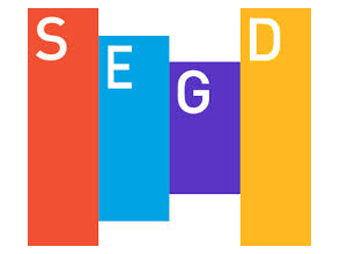 Whether they are planning, designing, or building wayfinding and signage systems, exhibition graphics, branded environments, or digital applications, members of the SEGD community have a common goal: creating experiences that connect people to place.
Whether they are planning, designing, or building wayfinding and signage systems, exhibition graphics, branded environments, or digital applications, members of the SEGD community have a common goal: creating experiences that connect people to place.
As SEGD—the Society for Environmental Graphic Design—celebrates its 40th anniversary this year, it has adopted a new mission statement that reflects the field’s increasing integration of technology and recognizes that its practitioners are creating digital as well as physical experiences.
The SEGD mission statement was recently updated by the SEGD Board of Directors as part of the organization’s continuing Strategic Plan process:
SEGD exists to Educate, Connect, and Inspire the global, multidisciplinary community of professionals who plan, design, and build experiences that connect people to place.
It expands the former mission statement’s reference to “communications in the built environment” by referring to not only the physical environment, but to the digital experiences increasingly being created by those who practice environmental graphic design.
“It is really exciting to articulate an expanded mission that takes us past the traditional idea of environmental graphics and embraces the idea of a range of experiences connecting people to place,” says Amy Lukas, partner in Infinite Scale (Salt Lake City) and president of the SEGD Board of Directors. “It’s especially appropriate as we enter our 40th anniversary year and look ahead to the next 40 years.
This is a positioning for the future of our field versus the past.”
SEGD was established in 1973 as a professional community for designers creating architectural signage. In the ensuing four decades, SEGD has extended beyond its roots in signage to encompass a broad spectrum of visual communications in the built environment, from wayfinding to branded environments, public art, and exhibition design.
SEGD CEO Clive Roux says the integration of digital technologies into the built world will continue to significantly impact the skillsets and project teams required for environmental graphic design projects. “Static signage communicates much like print, as a one-way controlled process that delivers a message at a precise point to help guide you in the environment. As digital technologies enter the environment, the potential exists to expand from one-way communication to a delivery of content and a two-way dialogue between the user and the technologies,” he notes. “Treated in a sensitive way, through design, it holds the potential to significantly improve the physical experience.”
“These dialogues are likely to be far less controlled than a one-way message delivery system,” Roux continues. “They are more dynamic and interactive, requiring design skills more commonly used to create websites and digital product interfaces than traditional wayfinding and signage solutions. These skills will need to become a part of the EGD professional’s toolbox, and the number and type of people working on a digital project will likely expand the size of the EGD design team in the same way as has happened with digital devices and websites. We want to ensure that SEGD includes all of those who will participate in these multidisciplinary teams in the future.”











